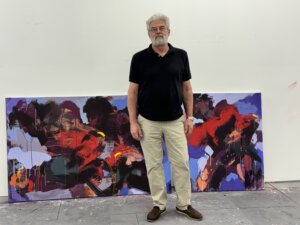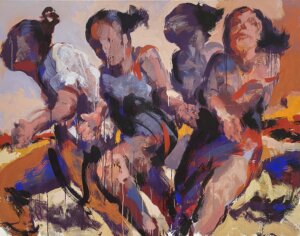How one artist turned the horrors of Oct. 7 into a bold series of paintings
The colors hit first: glowing apricot, smoky mauve, and black interrupted by thick streaks of crimson. They are the colors of conflagration. But it’s the life-size figures that command attention – each one emerging from the impasto, and appearing desperate to spring off the canvas.
The triptych is part of the figurative artist David Stern’s new series “Silent Running” about Oct. 7. Stern spent five months trying to pinpoint the core of that early autumn morning, when Hamas terrorists breached Israel’s border to murder, mutilate, and rape 1,200 people, mostly civilians and take 320 hostage, some of whom are still being held.
“The work is not a political reaction to the day. It is the theme itself that interested me, which goes a little further than the actual event. It’s about people being reduced to their creatureliness. When they were running they weren’t thinking about what they are or what they do. It was just about surviving,” Stern said.
Standing in his Westchester studio where dozens of canvases lean against glacial white walls and paint splatters the floor, Stern recalled that he only learned about the terror attack after sundown. It was Simchat Torah and his phone had been off all day.
“The word crashed down on us. It was immediately clear that this was on par with Eastern European pogroms. The main thing here was civilization broke down. It is a shocking moment,” he said.

Stern, whose work has been exhibited worldwide, including at the 9/11 Memorial & Museum and the Hungarian National Gallery in Budapest, has yet to exhibit the series.
In another painting, this one part of a diptych, a figure wearing something scarlet sprints for survival against a deep blue sky.
This work was inspired by a photograph which captured Vlada Patapov as she fled the Nova music festival. It is the only photograph Stern has looked at from that day because, he said, he doesn’t want to stand before the canvas with any preconceived notions about what the day looked or sounded like.
Stern, 68, was born in Essen, Germany to Jewish parents — one Dutch, the other German — who settled in Germany after the Holocaust. His earliest memory of experiencing art was visiting the Museum Folkwang, which houses a major collection of 19th- and 20th-century art, including works by Vincent Van Gogh and the expressionist Franz Marc.
Stern’s own style has been described as evoking the artistic legacies of New York School painters like Jackson Pollock, Willem de Kooning and Franz Kline. His previous subjects have included Israeli soldiers coming home after the second Lebanon war in 2006 and a “Pandemic Portrait series” painted while he was sheltering in place in 2020.

Stern lived and studied in Germany until 1994 when he and his wife decided to trade Cologne for New York. One year after he was naturalized as a U.S. citizen Al-Qaeda terrorists carried out the September 11 attacks. Out of that came his series “The Gathering.”Where that series was about collective mourning and the reaction of what he has described as the “speechless and stunned” observers to that day, “Silent Running” is about those who directly experienced a fateful situation.
“It’s about those who got away with their lives, it’s about how undiscriminating violence destroys the individual and their humanity and the very fabric of a civilized society,” he said.
The concept of mortality underpins much of Stern’s work. Indeed it’s something he started pondering as a child.
“I was eight or nine and I was sitting on a window sill on the third floor. Suddenly it occurred to me I could just fall down here or I could just jump down and I would be done. And that kind of blew me away,” Stern said.
Many years later he would read Ernest Becker’s The Denial of Death, which helped him to develop a sort of philosophy of life.
“You cannot live if you don’t accept you’re going to have to die,” he said. “Not that we will eventually die, but that we can die any minute. I could have a heart attack right now. Boom. There is no stability.”
The post How one artist turned the horrors of Oct. 7 into a bold series of paintings appeared first on The Forward.
from The Forward https://ift.tt/WEurzaO
Comments
Post a Comment